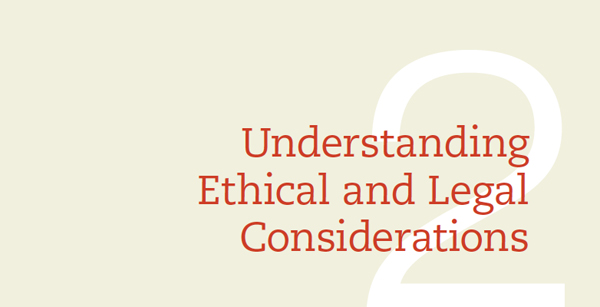2 Understanding Ethical and Legal Considerations
Printed Page 17-18

A Brief Introduction to Ethics
Your Ethical Obligations
OBLIGATIONS TO YOUR EMPLOYER
OBLIGATIONS TO THE PUBLIC
OBLIGATIONS TO THE ENVIRONMENT
Your Legal Obligations
COPYRIGHT LAW
• GUIDELINES: Determining Fair Use
• GUIDELINES: Dealing with Copyright Questions
• ETHICS NOTE: Distinguishing Plagiarism from Acceptable Reuse of Information
TRADEMARK LAW
• GUIDELINES: Protecting Trademarks
CONTRACT LAW
LIABILITY LAW
• GUIDELINES: Abiding by Liability Laws
The Role of Corporate Culture in Ethical and Legal Conduct
Understanding Ethical and Legal Issues Related to Social Media
• GUIDELINES: Using Social Media Ethically and Legally
• DOCUMENT ANALYSIS ACTIVITY: Presenting Guidelines for Using Social Media
Communicating Ethically Across Cultures
COMMUNICATING WITH CULTURES WITH DIFFERENT ETHICAL BELIEFS
COMMUNICATING IN COUNTRIES WITH DIFFERENT LAWS
Principles for Ethical Communication
ABIDE BY RELEVANT LAWS
ABIDE BY THE APPROPRIATE PROFESSIONAL CODE OF CONDUCT
ABIDE BY YOUR ORGANIZATION’S POLICY ON SOCIAL MEDIA
TAKE ADVANTAGE OF YOUR EMPLOYER’S ETHICS RESOURCES
TELL THE TRUTH
DON’T MISLEAD YOUR READERS
USE DESIGN TO HIGHLIGHT IMPORTANT ETHICAL AND LEGAL INFORMATION
BE CLEAR
AVOID DISCRIMINATORY LANGUAGE
ACKNOWLEDGE ASSISTANCE FROM OTHERS
WRITER’S CHECKLIST
EXERCISES
LEARNINGCURVE: Understanding the Technical Communication Environment and 
CASE 2: The Ethics of Requiring Students To Subsidize a Plagiarism-Detection Service and 
Ethical and legal issues are all around you in your work life. If you look at the website of any bike manufacturer, for example, you will see that bicyclists are always shown wearing helmets. Is this because bike manufacturers care about safety? Certainly. But bike makers also care about product liability. If a company website showed cyclists without helmets, an injured cyclist might sue, claiming that the company was suggesting it is safe to ride without a helmet.
Ethical and legal pitfalls lurk in the words and graphics of many kinds of formal documents. In producing a proposal, you might be tempted to exaggerate or lie about your organization’s past accomplishments, pad the résumés of the project personnel, list as project personnel some workers who will not be contributing to the project, or present an unrealistically short work schedule. In drafting product information, you might feel pressured to exaggerate the quality of the products shown in catalogs or manuals or to downplay the hazards of using those products. In creating graphics, you might be asked to hide an item’s weaknesses by manipulating a photo of a product.
One thing is certain: there are many serious ethical and legal issues related to technical communication, and all professionals need a basic understanding of them.